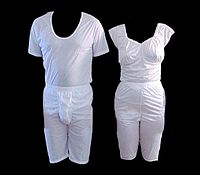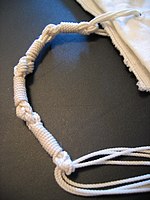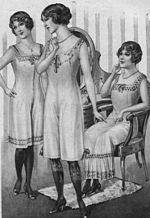| Revision as of 06:09, 20 November 2006 edit220.253.138.170 (talk) →See also← Previous edit | Revision as of 06:09, 20 November 2006 edit undoAntiVandalBot (talk | contribs)258,750 editsm BOT - rv 220.253.138.170 (talk) to last version by PKMNext edit → | ||
| Line 217: | Line 217: | ||
| * ] | * ] | ||
| * | * | ||
| * ] | |||
| * ] | |||
| * ] | |||
| * ] | |||
| * ] | |||
| * ] | |||
| * ] | |||
| * ] | |||
| * ] | |||
| * ] | |||
| ==Further reading== | ==Further reading== | ||
Revision as of 06:09, 20 November 2006
"Underwear" redirects here. For other uses, see Underwear (disambiguation). For the types and styles of women's undergarments, see lingerie.Undergarments, also called "underwear", "lingerie" (undergarments for women), or sometimes "intimate clothing" and "pants" in British English are clothes worn next to the skin, usually under other clothes.
Uses
Some clothing is specifically underwear, while some is also used as swimsuit (if made of suitable material), and both T-shirts and some shorts are suitable as underwear as well as outer clothing. Suitability as outer clothing is, apart from outdoor or indoor climate, largely a social and sometimes even a legal matter. One of the criteria for shorts not to be suitable as outer clothing may be that it has a fly that avoids exposure of the genitals just by an overlap of cloth, without buttons etc.
The two major types of men's underpants are boxer shorts (shorts-length and loose) and briefs (smaller and tighter), which are also referred to as Y-fronts in British English.
In addition to keeping outer garments from soiling, undergarments are worn for a variety of reasons: warmth, comfort and hygiene being the most common. Undergarments are often used for modesty or erotic display; sometimes both of these motivations are simultaneously present.
Hygiene is a major reason for the use of undergarments. It is usually more acceptable to have a soiled pair of undergarments than a pair of soiled trousers when one has an accident.
Religious significance


Undergarments can also have religious significance, as in the special temple garment worn by followers of the LDS Church (Mormons). Some Jews wear clothing that should neither touch the skin, nor be used as outer clothing: tallit katan or tzitzit. Every Jewish boy and man is supposed to wear Tzitzis (tassles) on undergarments, every day and always when attending synagogue . Some Hindus wear a sacred thread, called the Yajñopavītam, underneath their clothing. It is supported on the left shoulder and wrapped around the body, falling underneath the right arm. One of the five articles of the Sikh faith is underwear called kaccha, which are similar to boxer-shorts .
History
Ancient history

The loincloth is the simplest form of underwear; it was probably the first undergarment worn by human beings. A loincloth may take three major forms. The first, and simplest, is simply a long strip of material which is passed between the legs and then around the waist. The ancient Hawaiian malo was of this form, as are several styles of the Japanese fundoshi. Another form is usually called a cache-sexe: a triangle of cloth is provided with strings or loops, which are used to fasten the triangle between the legs and over the genitals. The alternate form is more skirt-like: a cloth is wrapped around the hips several times and then fastened with a girdle.
In warmer climates, the loincloth may be the only clothing worn (making it effectively not an undergarment), as was doubtlessly its origin, but in colder temperatures, the loincloth often forms the basis of a person's clothing and is covered by other garments. In most ancient civilizations, this was the only undergarment available (King Tutankhamun was buried with 145 of them).
Men are said to have worn loincloths in ancient Greece and Rome.
It is not clear whether Greek women wore undergarments. Roman women sometimes wore wrapped breastcloths or brassieres made of soft leather. They also seem to have worn loincloths and possibly something like panties. Decorative frescoes survive showing semi-nude women cavorting in breastwraps and loincloths .
Any cloth used may have been wool, linen or linsey-woolsey blend. Only the upper classes could have afforded imported silk.
The loincloth continues to be worn by people around the world (it is the traditional form of undergarment in many Asian societies, for example). In various -mainly tropical- cultures, the traditional male dress may still prescribe only a single garment below the waist or even at all, without underwear or only optionally, including the Far eastern Dhoti and Lungi or the Scottish kilt.
Middle Ages and Renaissance
Male undergarments

In the Middle Ages, western men's underwear became looser fitting. The loincloth was replaced by loose, trouser-like clothing called braies, which the wearer stepped into and then laced or tied around the waist and legs at about mid-calf. Wealthier men often wore chausses as well, which only covered the legs.
By the Renaissance, the chausses became form-fitting like modern Hose, and the braies became shorter to accommodate longer styles of chausses. However, chausses and many braies designs were not intended to be covered up by other clothing, so they are not actually underwear in the strictest sense.

Braies were usually fitted with a flap in the front that buttoned or tied closed. This codpiece allowed men to urinate without having to remove the braies completely. Henry VIII of England began padding his own codpiece, which caused a spiraling trend of larger and larger codpieces that only ended by the end of the 16th century. There are two possible explinations for Henry VIII's codpiece becoming larger and larger. It it speculated that he, along with many others in this time period, may have had the veneral disease syphilis. The large codpiece may have included a bandage soaked in medication to relieve the symptoms. It would then be wrapped again to protect the outer clothing. Henry VIII also wanted a healthy son and may have thought that projecting himself in this way would portray fertility.
The modern men's shirt appeared during this era,but it was originally an undergarment. Men would wear this long shirt under their other clothing and pull the long piece up from the back and then put their braies on over the shirt. In this way the shirt acted as underwear. Renaissance noblemen also adopted the doublet, a vest-like garment tied together in the front and worn under other clothing.
Female undergarments

Medieval women usually wore a close-fitting garment called a chemise or sometimes a shift or smock, sometimes coupled with braies-like leg wrappings.
They may have worn petticoats over the shift and under the dress. Quilted petticoats could be worn during the winter. Elaborately-quilted petticoats might be displayed by a cut-away dress, in which case they became a skirt rather than an undergarment.
During the 16th century, the farthingale was popular. This was a petticoat stiffened with reed or willow rods so that it stood out from a woman's body, like a cone extending from the waist.
Corsets also began to be worn about this time. At first they were called pair of bodies, which may refer both to a stiffened bodice designed to be seen, and a bodice stiffened with buckram, reeds, canes, whalebone etc., worn underneath another, decorative, bodice. These were not the small-waisted, curvy corsets familiar from the Victorian period, but straight-lined corsets that flattened the bust.
There is a myth that Crusaders worried about the fidelity of their wives and forced them to wear chastity belts. There is no reference, image, or surviving belt to support this story. In fact most historians of this period are of the view that chastity belts were worn to prevent sexual assault and that the woman kept the key.
Enlightenment and Industrial Age



The inventions of the spinning jenny machines and the cotton gin in the second half of the 18th century made cotton fabrics widely available. This allowed factories to mass-produce underwear, and for the first time, people began buying undergarments in stores rather than making them at home.
Women's stays of the 18th century were laced behind and drew the shoulders back to form a high, round bosom and erect posture. With the relaxed country styles of the end of the century, stays became shorter and were unboned or only lightly boned, and were now called corsets. Colored stays were fashionable.
As tight waists became fashionable in the 1820s, the corset was again boned and laced to form the figure. By the 1860s, a tiny ('wasp') waist came to be seen as a symbol of beauty, and the corsets were stiffened with whalebone or steel to accomplish this. By the 1880s, the dress reform movement was campaigning against the pain and damage to internal organs and bones caused by tight lacing. Inez Gaches-Sarraute invented the Health corset, with a straight-fronted bust made to help support the muscles of the wearer.
The corset was usually worn over a thin shirt-like garment of cotton or muslin called a shift. In the latter half of the 19th Century, long drawers, called pantalettes or pantaloons, often accompanied the shift to keep the legs out of sight as skirts styles got shorter.
As skirts became fuller from the 1830s, women wore a profusion of petticoats to achieve the fashionable bell shape. By the 1850s, stiffened crinolines and later hoop skirts allowed ever wider skirts to be worn.
The bustle, a frame or pad worn over the buttocks to enhance their shape, had been used off and on by women for two centuries, but it reached the height of its popularity the later 1880s, and went out of fashion for good in the 1890s.
The standard undergarment of the late 19th century for men, women and children was the union suit, which provided coverage from the wrists to the ankles (this "second skin" style is more commonly known as long johns today). The union suits of the era were usually made of knitted material and included a drop flap in the back to ease visits to the toilet. Drawers for women were not generally worn until the mid-nineteenth century when the adoption of crinolines made them necessary for reasons of modesty and warmth.
The jockstrap was invented in 1874 by C. F. Bennett of a Chicago sporting goods company, Sharp & Smith, to provide comfort and support for bicycle jockeys riding the cobblestone streets of Boston. In 1897 Bennett's newly-formed Bike Web Company patented and began mass-producing the Bike Jockey Strap.
1900s
By the early 20th century, the mass-produced undergarment industry was booming, and competition forced producers to come up with all sorts of innovative and gimmicky designs to compete. The Hanes company emerged from this boom and quickly established itself as a top manufacturer of union suits. Textile technology continued to improve, and the time to make a single union suit dropped from days to minutes.
Meanwhile, designers of women's undergarments relaxed the corset. The invention of new, flexible but supportive materials allowed them to remove the whalebone and steel while still providing support. The emancipation or liberty bodice offered an alternative to constricting corsets, and in Australia and the United Kingdom, the liberty bodice became a standard item, for girls as well as women.
1910s

The increase in the number of underwear manufacturers necessitated the birth of undergarment advertising. The first underwear print advertisement in the United States ran in the Saturday Evening Post in 1911 and featured oil paintings by J.C. Leyendecker of the "Kenosha Klosed Krotch". Early underwear advertisements placed emphasis on durability and comfort; fashion was never a selling point.
By the end of the 1910s, Chalmers Knitting Company split the union suit into upper and lower sections, effectively inventing the modern undershirt and drawers. Women wore lacier versions of this basic duo known as the camisole and drawers.
In 1913, a New York socialite named Mary Phelps Jacob changed women's fashion forever when she cobbled the first brassiere together by tying two handkerchiefs together with ribbon. Jacob's original intention was to cover the whalebone sticking out of her corset, which was visible through her sheer dress. Jacob began making brassieres for her family and friends, and word of mouth soon spread about the garment. By 1914, Jacob had a patent for her design and was marketing it throughout the United States. Although women had worn brassiere-like garments years past, Jacob's was the first to be successfully marketed and widely adopted.
In 1912, the United States had its first professional underwear designer. Lindsay "Layneau" Boudreaux, an immigrant from France established the short lived panty company "Layneau". Though her company closed within one year, it had a significant impact on many levels. Boudreaux showed the world that an American woman could establish and run a company, and she also caused a revolution in the underwear industry. Boudreaux is possibly the reason why up-scale underware and panty stores exist today.
By the end of the decade, trouser-like "bloomers" (popularized by Amelia Jenks Bloomer 1818-1894 but invented by Elizabeth Smith Miller) gained popularity with the so-called Gibson girls who enjoyed more athletic pursuits such as bicycling and tennis. This new female athleticism helped push the corset out of style, as well. The other major factor in the corset's demise was the fact that metal was in short supply in much of the world during World War I. Steel-laced corsets were dropped in favor of the brassiere.
Meanwhile, the soldiers of World War I were issued button-front shorts as underwear. The buttons attached to a separate piece of cloth, or yoke, sewn to the front of the garment, and tightness of fit was adjusted by means of ties on the sides. This design proved so popular that it began to supplant the union suit in popularity by the end of the war. Garments of rayon also became widely available in the post-war period.
1920s

In the 1920s, manufacturers shifted emphasis from durability to comfort. Union suit ads raved about "patented" new designs that reduced the number of buttons and increased accessibility. Most of these experimental designs had to do with new ways to hold closed the crotch flap common on most union suits and drawers. A new woven cotton fabric called nainsook gained popularity in the 1920s for its durability. Retailers also began selling preshrunk undergarments.
Women's bloomers became much shorter and stockings covered the legs instead. The shorter bloomers became looser and less supportive as the boyish flapper look came into fashion. By the end of the decade, they came to be known as step-ins, very much like modern panties but with wider legs, worn for the increased flexibility they afforded.
As dancing became a favorite pastime of young flappers, the garter belt was invented to keep stockings from falling. Nevertheless, the increased sexuality of the flapper also made underwear sexier than ever before. It was the flappers who ushered in the era of lingerie.
A Russian immigrant named Ida Rosenthal further developed the brassiere in this decade when she introduced modern cup sizes in 1928 for her company, Maidenform.
1930s
Modern men's underwear was largely an invention of the 1930s. On January 19, 1935 Coopers Inc. sold the world's first briefs in Chicago. The company placed a Y-shaped front and overlapping fly on knitted drawers in both short and long styles. They dubbed the design the "Jockey" since it offered a degree of support that had previously only been available from the jockstrap (the company itself would later adopt the name Jockey, as well). Jockey briefs proved so popular that over 30,000 pairs were sold within three months of their introduction.

Meanwhile, other companies began selling buttonless drawers fitted with an elastic waistband, the first true boxer shorts (named for their resemblance to the shorts worn by professional fighters). Scovil Manufacturing also introduced the snap fastener at this time, which became a popular addition to various kinds of undergarments.
Women of this decade brought the corset back, now called the girdle. The garment lacked the whalebone and metal supports and usually came with a brassiere (now usually called a bra) and often garters attached.
1940s
During World War II, elastic waistbands and metal snaps gave way once again to button fasteners due to rubber and metal shortages. Undergarments were harder to find, as well, since soldiers abroad had priority to get them.
At war's end, Jockey and Hanes remained the industry leader in the United States, but Cluett, Peabody and Company would make a name for itself when it introduced a preshrinking process called Sanforization, which came to be licensed by most major manufacturers.
Meanwhile, some women readopted the corset once again, now called the waspie for the wasp-shaped waistline it gave the wearer. Many women began wearing the strapless bra, as well, which gained popularity for its ability to push the breasts up and enhance cleavage.
1950s and 1960s

In the 1950s, underwear manufacturers began marketing printed and colored garments. What had once been a simple, white piece of clothing not to be shown in public suddenly became a fashion statement. The manufacturers also experimented with rayon and newer fabrics like dacron and nylon. By 1960, men's underwear was regularly printed in loud patterns or with images ranging from messages to cartoon characters.
Women's undergarments began to emphasize the breasts instead of the waist in the 1950s. The decade saw the introduction of the bullet bra, which featured pointed cups. Fredericks of Hollywood's push-up bra finally hit it big in this decade as well. Meanwhile, women's panties had become even more colorful and decorative, and by the mid-Sixties were also available in two smaller, more abbreviated styles called the hip-hugger and the bikini (after the island of that name), frequently in sheer nylon fabric.
Pantyhose, also called "tights" in British English, which combined panties and hose into one garment, made their first appearance in 1959, invented by Glen Raven Mills of North Carolina. The company later introduced seamless pantyhose in 1965, spurred by the popularity of the miniskirt.
1970s till the present day


Underwear as fashion matured in the 1970s and 1980s, and underwear advertisers forgot about comfort and durability, at least in advertising. Sex appeal became the main selling point, in swimwear as well, bringing to fruition a trend that had been building since at least the flapper era (underwear is the last barrier before nudity, and thus it acts as a sort of gatekeeper to sex).
- Tank tops, an undershirt type named after the Tank suit swimwear which dates from the 1920s, have been popular warm-weather casual wear in the United States since the 1980s and are regarded as acceptable public casual dress in most locales there.
- Performers in the 1980s such as Madonna and Cyndi Lauper also got into the act, often wearing undergarments on top of other clothes.
Later, in the 1990s, hip hop stars would popularize a similar style, known as the sag, which allowed loosely fitting blue jeans or shorts to droop low, exposing the underwear. In fact, in the case of Mark Wahlberg, it was his success as underwear model for Calvin Klein (pioneering in sexy exposure of male flesh) that allowed him a double launch to showbiz fame as the first white hip hop star and as a respectable Hollywood hunk.
- Although it was worn for decades by exotic dancers, the thong first gained popularity in South America, particularly in Brazil, in the 1980s. It was originally a style of swimsuit made so that the back of the suit is so thin that it disappears between the buttocks. By the 1990s, the design had made its way to most of the Western World, and thong underwear became popular. Today, thong underwear is one of the fastest selling styles available among women and is even gaining some popularity among men.
- In the 1990s, retailers started selling boxer briefs, which take the longer shape of boxers but maintain the tightness of briefs. Though marketed as a new design, these are actually quite similar to the bottom half of the two-part union suits worn in the 1910s.
Underwear styles and function

Today, there are many options in underwear available. These include:
- boxer style (at or near true waist, leg sections extending to thighs)
- woven boxer (traditional)
- knit boxer (like traditional but with more fabric give)
- boxer brief (also knit; more form-fitting)
- pouch boxer brief (boxer briefs but with pouch for genitals rather than access flap)
- athletic-style (skin-tight, usually with no access pouch or flap; like short tights; a variety also is [[bike shorts
- retro style (boxer shorts in a brief style)
- brief style (knit fabric, with access pouch or flap; usually at or near true waist, leg bands at tops of thighs)

Sunbather in bikini - traditional brief (vertical flap)
- double seat brief or double back brief
- diagonal flap brief
- pouch brief
- low-cut/low-rise brief
- bikini brief (usually lower than true waist, often at hips, usually no access pouch or flap, legs bands at tops of thighs)
- high-side bikini brief
- low-side bikini brief
- string bikini brief (the front and rear sections meet in the crotch with a shoestring-like thread at the top, with no fabric on the side of the legs)
- g-string type (with a front pouch for the genitals but no rear coverage)
- thong (with a strap securing the pouch at the bottom rear, passing up the crack between the buttocks to the waistband)
- athletic supporters, also known as jockstraps (with two straps securing the pouch at the bottom rear, passing around the bases of the buttocks up to the waistband at the sides) and dance belt
- strapless pouches (with a front pouch and waistband only, no securing straps)
There are also many types of long underwear, union suits, and other variations of men's underwear. Some underpants also have a fly. These usually do not allow detachment at the waist; elasticity allows them to be taken on and off. Usually the fly of underpants avoids exposure of the skin just by an overlap of cloth, without buttons, etc. Such a property may be one of the criteria for boxer shorts not to be suitable as outer clothing.
Today, there are many specialized types of underwear made for sexual purposes, such as edible underwear or crotchless panties. Most of these are meant simply to display the body or genitals in certain ways, while some are intended to provide genital stimulation as well. Frederick's of Hollywood is an example of a business centered around manufacturing and selling such underwear.
Not wearing undergarments
Main article: Going commandoNot wearing undergarments under one's outer clothing is known in American slang as freeballing for men or freebuffing for females; the terms going commando and going bareback are also used for both sexes. .
This trend shows that not everybody considers underwear essential for hygiene, especially for modern people who bathe every day.
In situations where a certain amount of body coverage is required (legally or socially), people who prefer to go clothes free might enjoy not wearing undergarments, as that is the closest they can get to nudity. For others, there may be sexual motives; undergarments are the final physical barrier to sex, and not wearing them might be arousing.
Cycling shorts and swimwear such as board shorts are usually worn without underwear. Often the same applies for a kilt; the uniforms of several Scottish military regiments mandate wearing no underwear with the kilt except at specified occasions.
Underwear exposed above trousers
Underwear is sometimes partly exposed above the trousers when sitting, bending over, etc., or permanently. This depends on the style of trousers (see also low-rise jeans, hip-hugger), the style of underwear, and the way they are worn. It may be accidental or deliberate. When women (deliberately or not) show their underwear in this way it is sometimes called a "visible panty line", or VPL. When women wearing thong underwear expose themselves in this way, it is sometimes called a "whale tail".
"Sagging" refers to one who's trousers do not ride at the waist, rather lower on the hips as to expose their underwear. This style first appeared in male prisons where inmates who were sexually availiable for other men would 'sag' their trousers.
See also
- A-shirt
- Beachwear
- Boy shorts
- Brassiere
- Briefs
- BVD
- Clothing
- Corset
- Crinoline
- Diaper
- Farthingale
- Hoop skirt
- Hosiery
- Laws on underwear exposure
- Lingerie
- Long underwear
- Pantalettes
- No Pants Day ('pants' = trousers in this context, not undergarments)
- Sagging
- Social aspects of clothing
- Swimsuit
- T-shirt
- Undershirt
- Wifebeater
- Underwear brands
Further reading
- The History of Underclothes by C. Willett Cunnington & Phillis Cunnington, 1951, Dover
External links
- The Council of Textile & Fashion Industries of Australia
- History of Underwear on mum.org
- A thorough history of 20th century underwear
- The origin of underwear
- Historical Lingerie pictures from the New York Public Library Picture Collection
- Great Underwear